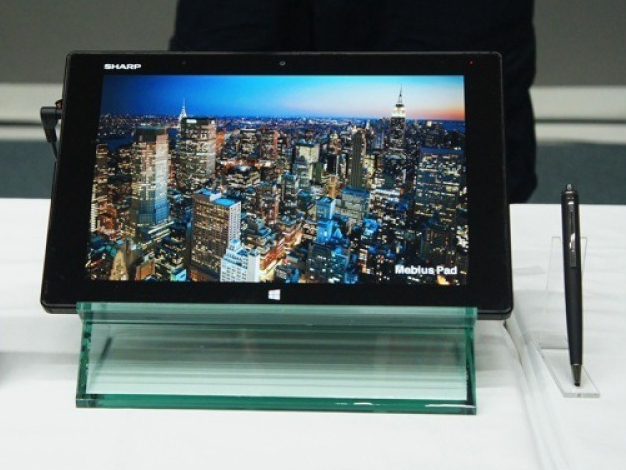Sharp Demos New MEMS Displays, First Windows 8 Tablet
On Monday during CEATEC Japan 2013, Sharp began showcasing prototype next-generation 7 inch MEMS displays with a 1280 x 800 resolution. The colors were reportedly bright and the screen image sharp, but some viewers reported a brief flash of red, green and blue pixels each time they looked away from the screen. A Sharp representative said the company is currently working on the issue.
These MEMS screens, short for MicroElectroMechanical Systems, are in development at Sharp in conjunction with Qualcomm. A backlight that quickly flashes red, blue and yellow resides behind each pixel, and a tiny shutter in the front that opens and closes, allowing or blocking the light. Thus, these shutters can control the amount of light that passes through the pixel, creating what the eye perceives as a hue.
This is different than current LCD screens that use three filters. Akira Imai, deputy general manager of Sharp's new business development center, said these LCD filters "swallow" around two-thirds of the brightness of the backlighting before leaving the display. By comparison, MEMS displays allow all the light to shine through, so the intensity can actually be reduced, draining less power from the battery.
Qualcomm said back in June that it had completed its investment into Sharp, giving the company 3.53 percent ownership of the struggling display maker. Before that, Qualcomm said in December 2012 that subsidiary Pixtronix and Sharp would develop and commercialize MEMS displays using Sharp's IGZO technology and existing LCD technology, backed by Qualcomm's equity investment.
Sharp was also displaying during the CEATEC show the Mebius Pad, the company's first Windows 8.1-based tablet featuring a 2560 x 1600 resolution, a 10.1 inch display, and an Intel Atom Z3370 quad-core chip. The device promises to be both water-proof and dust-proof, and is currently awaiting certification for IPX5, IPX7 and IP5X. A 4G LTE version will be offered when the tablet goes on sale in early 2014. So far it's unknown if the tablet will ship to territories other than Japan.
Get Tom's Hardware's best news and in-depth reviews, straight to your inbox.

Kevin Parrish has over a decade of experience as a writer, editor, and product tester. His work focused on computer hardware, networking equipment, smartphones, tablets, gaming consoles, and other internet-connected devices. His work has appeared in Tom's Hardware, Tom's Guide, Maximum PC, Digital Trends, Android Authority, How-To Geek, Lifewire, and others.
-
IndignantSkeptic So the color components are just temporally instead of spatially separated?Reply
I bet they will try to resolve or rather reduce the problem by increasing how rapidly the screen switches between the color components. -
TeraMedia IMO this is heading in the wrong direction. It still involves backlighting the entire display area, and then selectively passing or blocking portions of that to create images. And now it also involves moving parts a la DLP (but different design). OLED and Sony's Crystal LED technology seem to me to be heading more in the right direction: solid state, no spatial light filtering, and high-fidelity intensity control. The first company that gets to the point of being able to "print" LEDs and related switches and circuits on a transparent panel is going to own the display market. Everything else will become like CRTs.Reply -
IndignantSkeptic Yeah I'm getting really annoyed now about OLED being delayed still. I actually miss CRT. I stopped using CRT only because I heard it generates X-rays.Reply -
Old_Fogie_Late_Bloomer "A backlight that quickly flashes red, blue and yellow resides behind each pixel..."Reply
I'm pretty sure you didn't mean yellow... :-) Green is really the better choice for these sorts of applications.
